Lisa Schulte Moore sees the Iowa caucuses as an opportunity to spotlight innovative and “regenerative” farming methods that produce goods and services while also improving soil and water resources, unique habitats and pastoral countrysides.
Strips of native prairie grasses planted on Larry and Margaret Stone's Iowa farm protect soil, water and wildlife. (Iowa State University/Omar de Kok-Mercado, CC BY-ND)
By Lisa Schulte Moore | The Conversation | November 7, 2019
Iowa's first-in-the-nation caucuses bring the state a lot of political attention during presidential election cycles. But in my view, even though some candidates have outlined positions on food and farming, agriculture rarely gets the attention it deserves.
As a scientist at Iowa's land-grant university, I believe our state is at the forefront of redefining what agriculture could be in the U.S., and addressing environmental and economic challenges associated with the extensive monocultures that dominate our current system. I think these conversations should be at the forefront nationally. After all, everyone needs to eat, so all Americans have a stake in the future of farming.
Judging produce on opening day of the 2019 Iowa State Fair. (AP/Charlie Neibergall)
As Iowa Farms, So farms the Nation
Iowa is a leading global producer of corn, soy, pork, beef, eggs, ethanol, biodiesel, biochemicals and agricultural technology. Because it is home to just 3.2 million people, Iowa farmers export the vast majority of what they produce. Most multinational agricultural businesses have Iowa offices, and the state also has considerable influence on U.S. farm bill legislation. Iowans are also acutely aware of the challenges of modern agriculture, which affect their lands and livelihoods. They include soil degradation, water contamination, flooding and loss of carbon and habitat for native species.
Farmers understand these effects, and many are actively working to reduce them, as operational, financial and social conditions allow. One example in which I am involved is the STRIPS project, in which scientists, farmers, land owners and others are partnering to test the effects of seeding narrow strips with native prairie plants within and around corn and soybean fields.
Over the last 13 years, we have shown that prairie is a valuable tool for protecting water supplies and providing habitat for wildlife, including pollinators. Planting just 10 percent of farm fields – often in the least productive zones – with stiff-stemmed native prairie grasses helps hold water and sediment in place, reducing erosion and nutrient loss from fields. The strips also contain flowering plants that support birds and insects, including pollinators and natural enemies of crop pests.
Restoring the Balance: Prairie Conservation Strips (STRIPS the Movie)
This approach can turn low-yielding acres into an opportunity to reduce use of inputs such as fertilizer and pesticides. Today there are nearly 600 acres of prairie strips on about 5,000 acres of cropland on 66 farms across in six Midwestern states. My colleagues and I expect these numbers to grow dramatically now that the U.S. Department of Agriculture is supporting prairie strips as a conservation tool.
Please go to Consortium News to read the entire article.
________
Hydroponics is a great alternative. Would it be possible for some sort of cooperative effort between farmers to organize to combine resources to start investing in and building out hydroponics systems like True Gardens' operation in Arizona? Hydroponics systems like the one True Garden has set up can feed 100 families a week. Families can also set up hydroponics systems for their own food needs which in turn would allow soil that is farmed to recover from decades and decades of exploitation. If hydroponics started replacing even a small percentage of vegetable production in Iowa, the relief to the soil would be astonishing.
Learn all about how to grow a hydroponic garden, and how it can save you money. In this video learn all about hydroponics. This 17 year old is saving his family money and running a business with hydroponic gardening. All we need is American enginuity and some creativity so that we can start having a serious conversation with American eaters.
Related:
The Agriculture Course By Rudolf Steiner


No comments:
Post a Comment
Note: Only a member of this blog may post a comment.